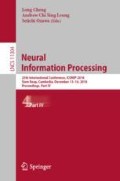Abstract
Using lower limb rehabilitation robots to help stroke patients recover their walking ability is becoming more and more popular presently. The natural and personalized gait trajectories designed for robot assisted gait training are very important for improving the therapeutic results. Meanwhile, it has been proved that human gaits are closely related to anthropometric features, which however has not been well researched. Therefore, a method based on anthropometric features for prediction of patient-specific gait trajectories is proposed in this paper. Firstly, Fourier series are used to fit gait trajectories, hence, gait patterns can be represented by the obtained Fourier coefficients. Then, human age, gender and 12 body parameters are used to design the gait prediction model. For the purpose of easy application on lower limb rehabilitation robots, the anthropometric features are simplified by an optimization method based on the minimal-redundancy-maximal-relevance criterion. Moreover, the relationship between the simplified features and human gaits is modeled by using a random forest algorithm, based on which the patient-specific gait trajectories can be predicted. Finally, the performance of the designed gait prediction method is validated on a dataset.
This research is supported by the National Natural Science Foundation of China (Grants 91648208) and Beijing Natural Science Foundation (Grant3171001).
Access this chapter
Tax calculation will be finalised at checkout
Purchases are for personal use only
References
Winstein, C.J., et al.: Guidelines for adult stroke rehabilitation and recovery: a guideline for healthcare professionals from the american heart association/american stroke association. Stroke 47(6), e98 (2016)
Swinnen, E., Beckwe, D., Meeusen, R., Baeyens, J.P., Kerckhofs, E.: Does robot-assisted gait rehabilitation improve balance in stroke patients? a systematic review. Top. Stroke Rehabil. 21(2), 87–100 (2014)
Jezernik, S., Colombo, G., Morari, M.: Automatic gait-pattern adaptation algorithms for rehabilitation with a 4-dof robotic orthosis. IEEE Trans. Robot. Autom. 20(3), 574–582 (2004)
Banala, S.K., Kim, S.H., Agrawal, S.K., Scholz, J.P.: Robot assisted gait training with active leg exoskeleton (alex). IEEE Trans. Neural Syst. Rehabil. Eng. 17(1), 2–8 (2009)
Esquenazi, A., Talaty, M., Packel, A., Saulino, M.: The rewalk powered exoskeleton to restore ambulatory function to individuals with thoracic-level motor-complete spinal cord injury. Am. J. Phys. Med. Rehabil. 91(11), 911–921 (2012)
Luu, T.P., Lim, H., Qu, X., Hoon, K., Low, K.: Subject-specific lower limb waveforms planning via artificial neural network. In: 2011 IEEE International Conference on Rehabilitation Robotics, pp. 1–6. IEEE (2011)
Koopman, B., van Asseldonk, E.H., Van der Kooij, H.: Speed-dependent reference joint trajectory generation for robotic gait support. J. Biomech. 47(6), 1447–1458 (2014)
Luu, T.P., Lim, H.B., Qu, X., Low, K.: Subject tailored gait pattern planning for robotic gait rehabilitation. In: 2010 IEEE International Conference on Robotics and Biomimetics, pp. 259–264, December 2010
Luu, T., Low, K.H., Qu, X., Lim, H.B., Hoon, K.H.: An individual-specific gait pattern prediction model based on generalized regression neural networks. Gait Posture 39(1), 443–448 (2014)
Yun, Y., Kim, H.C., Shin, S.Y., Lee, J., Deshpande, A.D., Kim, C.: Statistical method for prediction of gait kinematics with gaussian process regression. J. Biomech. 47(1), 186–192 (2014)
Peng, H., Long, F., Ding, C.: Feature selection based on mutual information: criteria of max-dependency, max-relevance, and min-redundancy. IEEE Trans. Pattern Anal. Mach. Intell. 27, 1226–1238 (2005)
Breiman, L.: Random forests. Mach. Learn. 45(1), 5–32 (2001)
Refaeilzadeh, P., Tang, L., Liu, H.: Cross-validation. In: Encyclopedia of Database Systems, pp. 532–538. Springer, New York (2009)
Author information
Authors and Affiliations
Corresponding author
Editor information
Editors and Affiliations
Rights and permissions
Copyright information
© 2018 Springer Nature Switzerland AG
About this paper
Cite this paper
Ren, S., Wang, W., Hou, ZG., Liang, X., Wang, J., Peng, L. (2018). Anthropometric Features Based Gait Pattern Prediction Using Random Forest for Patient-Specific Gait Training. In: Cheng, L., Leung, A., Ozawa, S. (eds) Neural Information Processing. ICONIP 2018. Lecture Notes in Computer Science(), vol 11304. Springer, Cham. https://doi.org/10.1007/978-3-030-04212-7_2
Download citation
DOI: https://doi.org/10.1007/978-3-030-04212-7_2
Published:
Publisher Name: Springer, Cham
Print ISBN: 978-3-030-04211-0
Online ISBN: 978-3-030-04212-7
eBook Packages: Computer ScienceComputer Science (R0)

